數據冒險控制冒險
Labor productivity is considered one of the most important indicators of a country’s well-being. However, we don’t know so much about it, let’s try to figure out how it is calculated, and how things are with it in the world (data source: Total Economy Database).
勞動生產率被認為是一個國家福祉的最重要指標之一。 但是,我們對其了解不多,讓我們嘗試弄清楚它的計算方式以及它在世界上的狀況(數據來源: Total Economic Database )。

We will find out the answer a little bit later.
我們稍后會找到答案。
Labor productivity objectively reflects the health of an economy, it is based on two indicators: the country’s GDP per capita and the proportion of the employed population. The same formula can be written in another way:
勞動生產率客觀地反映了經濟的健康狀況,它基于兩個指標:該國的人均GDP和就業人口的比例。 可以用另一種方式寫相同的公式:

Let’s revise what GDP and GDP per capita are. GDP is the gross domestic product, which represents the total market value of all final goods and services produced in a country. GDP per capita shows how much gross domestic product is produced by one person on average (GDP / population). Both indicators are measured annually and for comparison purposes in the same currency — US dollars.
讓我們修改一下GDP和人均GDP。 GDP是??國內生產總值,代表一個國家生產的所有最終商品和服務的總市場價值。 人均國內生產總值顯示一個人平均生產多少國內生產總值(國內生產總值/人口)。 兩項指標均以美元為單位,每年進行測量,以作比較。
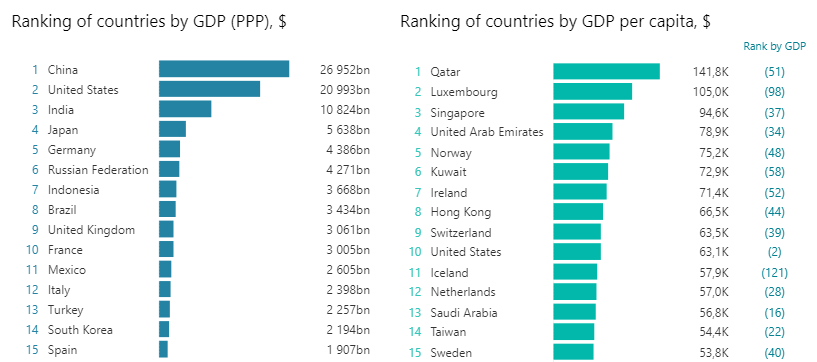
The charts show that a high GDP does not mean that GDP per capita will also be high. For example, China ranks first in terms of GDP and produces the largest number of goods and services in the world. But neither GDP per capita, nor its labor productivity are included in the TOP 10, they hold the 61st and the 78th places respectively, on the same level as Colombia and Brazil (which, by the way, are also in the TOP 10 countries for GDP):
圖表顯示,高GDP并不意味著人均GDP也很高。 例如,中國的GDP排名第一,生產的商品和服務數量居世界首位。 但是,人均GDP和勞動生產率均未列入前10名,它們分別排名第61位和第78位,與哥倫比亞和巴西處于同一水平(順便說一下,哥倫比亞和巴西在前10名中也GDP):

Why is this mismatch? Firstly, China is the most populous country. When allocating 25 billion GDP per 1.4 billion people, the value is several times lower than in most countries. Secondly, people work a lot there — the percentage of the employed population in 2019 was 55.6%, which is higher than the average by 10–12%. Thirdly, there are cheap or low-tech products in China.
為什么不匹配? 首先,中國是人口最多的國家。 當以每14億人口分配250億美元的GDP時,其價值要比大多數國家低幾倍。 其次,那里的人們工作很多— 2019年的就業人口百分比為55.6%,比平均水平高10-12%。 第三,中國有廉價或低技術含量的產品。
該國勞動生產率高的三個原因: (3 reasons for high labor productivity in the country:)
- Low cost of the final product, but a large production volume + a low percentage of employed people. The conditions that are applicable to the Arabic countries that produce cheap oil and do not spend a lot of effort and time on it. 最終產品的成本低,但產量大,從業人員比例低。 適用于生產廉價石油且無需花費大量精力和時間的阿拉伯國家的條件。
- High GDP per capita + high or average percentage of employed people. This pattern is typical for the United States and most Western European countries — the entire working-age population works and produces high-value products. Qatar became an unexpected participant in this group. Its high labor productivity is ensured not by a low percentage of employed people as in other oil-producing countries, but by a higher cost of the finished product and large volumes of its production. 人均GDP高+就業人口百分比高或平均。 這種模式在美國和大多數西歐國家都是典型的-整個工作年齡人口都在工作并生產高價值的產品。 卡塔爾成為該組的意外參與者。 它的高勞動生產率不是通過像其他產油國那樣低的就業人數來確保的,而是通過成品成本較高和大量生產來保證的。
- High GDP per capita + low percentage of employment. This situation is rare, but it is the future — there is a small proportion of the employed population which produces an expensive product. 人均GDP高+就業率低。 這種情況很少見,但這是未來的情況-就業人口中有一小部分生產昂貴的產品。
俄國 (Russia)
We have looked at the leaders in the main economic indicators. Now we will find Russia in these ratings. In terms of GDP, Russia is ahead of many countries — the news and economic books tell us that. Indeed, in 2019, Russia was on the 6th place in the world GDP ranking (PPP). But it did not become a leader in labor productivity.
我們已經考察了主要經濟指標中的領導者。 現在,我們將在這些評級中找到俄羅斯。 就GDP而言,俄羅斯領先于許多國家-新聞和經濟書籍告訴我們。 確實,在2019年,俄羅斯在世界GDP排名(PPP)中排名第六。 但是它并沒有成為勞動生產率的領導者。
Let’s test your intuition again.
讓我們再次測試您的直覺。
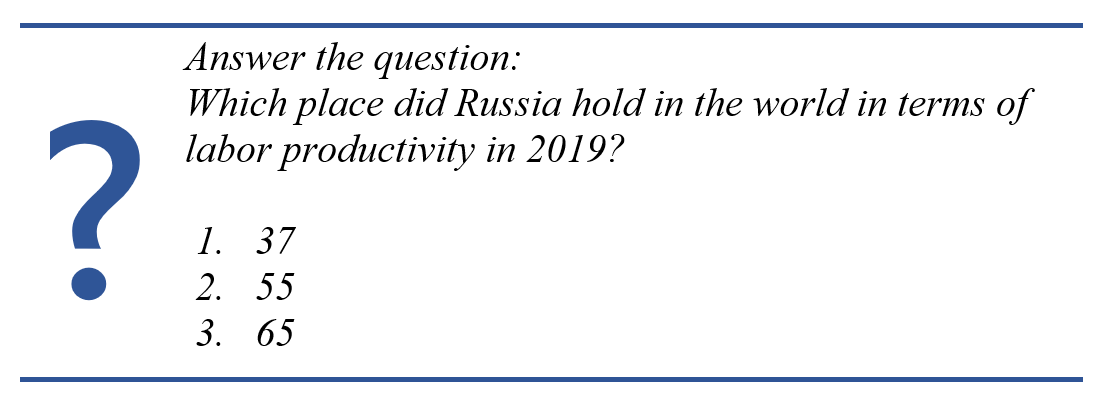
We have collected all the most important macroeconomic indicators on a single dashboard.
我們在一個儀表板上收集了所有最重要的宏觀經濟指標。
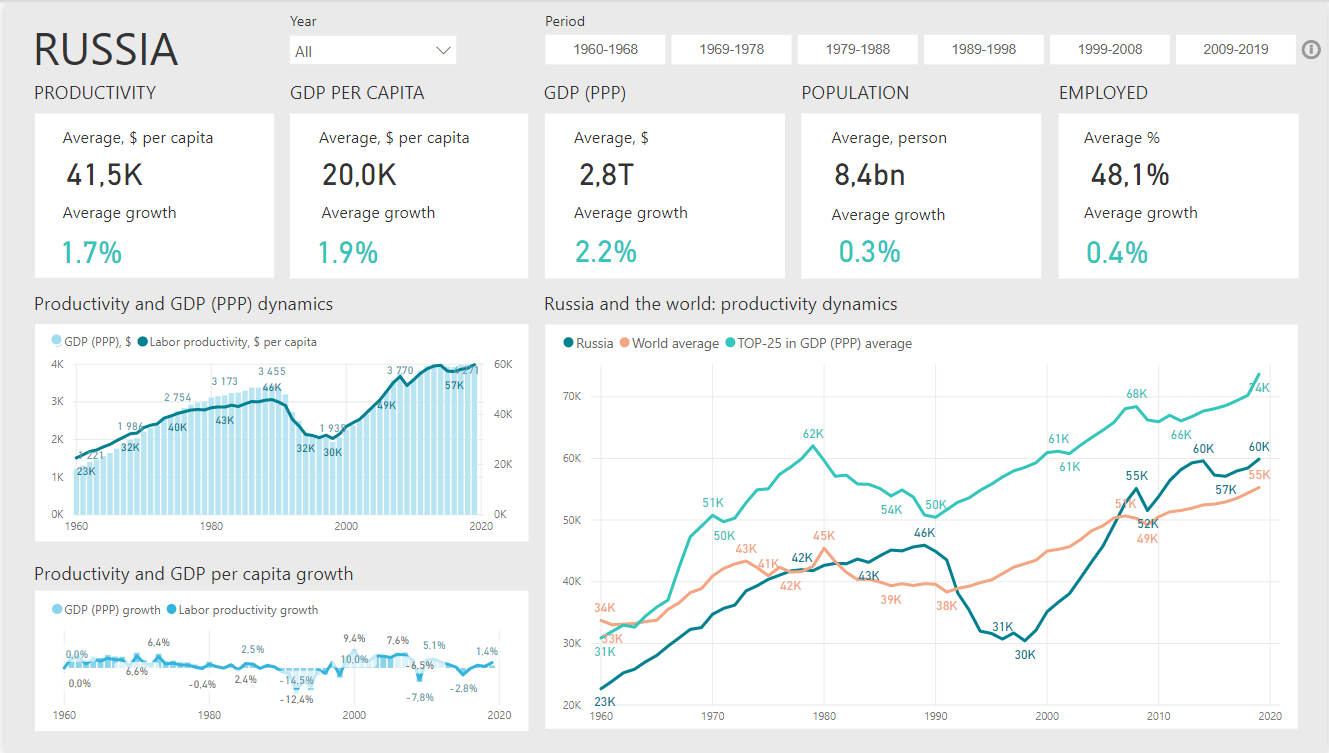
What does the dashboard show? Since the beginning of the 1960s, labor productivity in Russia (RSFSR) had a mainly positive dynamic. After the collapse of the Soviet Union, the productivity index fell sharply in Russia and the CIS countries, and it returned to the value of 1989 only by 2005. The positive dynamic of labor productivity was brought down by the crisis of 2008, but in 2010 it began to grow again and reached its maximum in 2019 ($59,900 per capita).
儀表板顯示什么? 自1960年代初以來,俄羅斯的勞動生產率(RSFSR)主要呈積極變化。 蘇聯解體后,俄羅斯和獨聯體國家的生產率指數急劇下降,到2005年才恢復到1989年的值。2008年的危機降低了勞動生產率的積極動力,但到了2010年它開始再次增長并在2019年達到最高水平(人均59,900美元)。
Labor productivity in Russia follows all changes in GDP. Where the graph line does not coincide with the tops of the bars, the second factor (the number of employed people) affects: the bars below the graph mean that % of employed people falls, the bars above the graph show that % of the working population increases.
俄羅斯的勞動生產率跟隨GDP的所有變化。 如果圖表線與條形圖的頂部不一致,則第二個因素(受雇人數)會受到影響:圖表下方的條形圖表示失業人數下降,圖表上方的條形圖表示工作百分比人口增加。
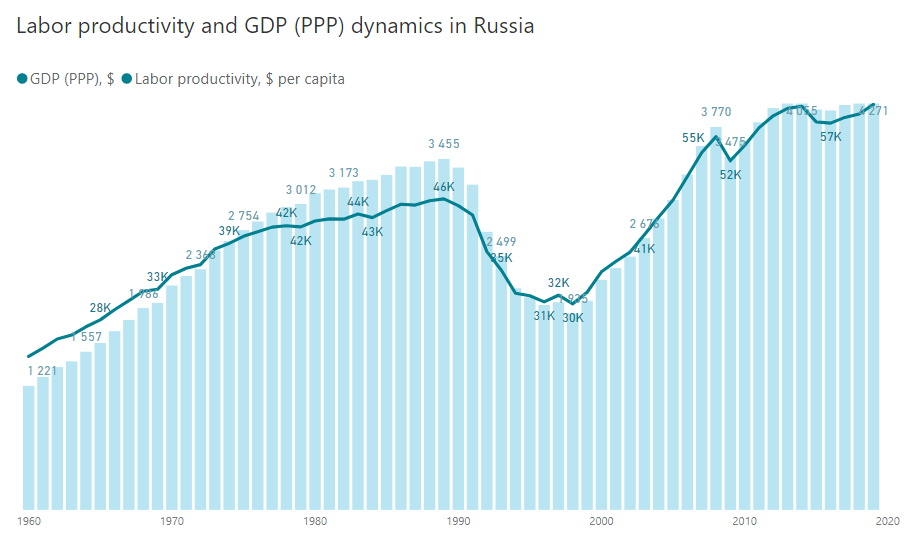
俄羅斯與世界 (Russia and the world)
Labor productivity in Russia has never taken a leading position in the world. It raised to its highest position in the rating during the USSR period. The best result throughout all years was the 32nd place in 1968, the worst result was the 61st place in 1997 and 1998. After that, Russia has not risen above the 48th line of the rating. In 2019 Russia was ranked 55th in the world.
俄羅斯的勞動生產率從未在世界上占據領先地位。 在蘇聯時期,它升至該等級的最高位置。 全年最好的成績是1968年的第32位,最差的成績是1997年和1998年的第61位。此后,俄羅斯一直沒有超過該排名的第48位。 俄羅斯在2019年排名世界第55位。
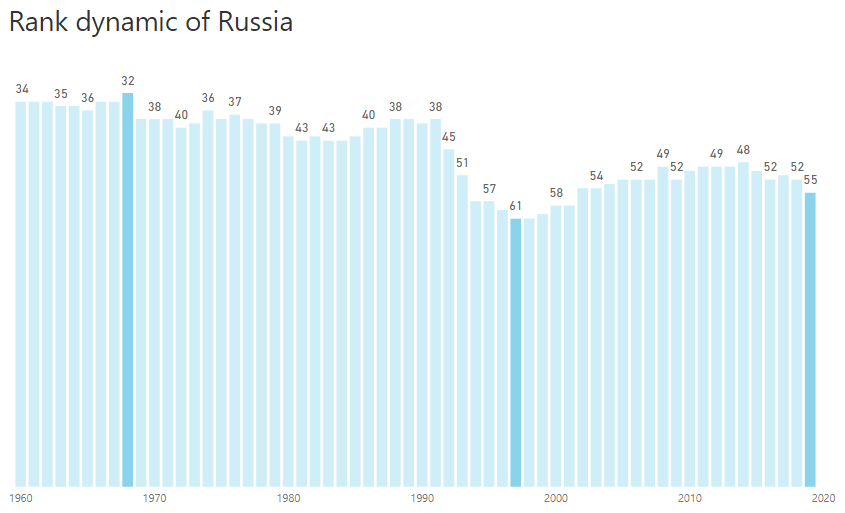
It is also interesting to see the dynamics of labor productivity in Russia against the background of the world average indicator and the average for the TOP 25 countries leading in terms of GDP. Russia has never outperformed the latter indicator.
有趣的是,在世界平均指數和在GDP方面領先的前25個國家的平均數的背景下,看到了俄羅斯勞動生產率的動態。 俄羅斯從未超越后者。
Now a few positive moments. Since 1982 Russia has exceeded the world average in terms of labor productivity. After the collapse of the Soviet Union and until 2006 it was below the average indicator again, but having caught up with it in 2007, it no longer falls below and tends to catch up with the leaders in GDP. Even the 2008 crisis did not break this positive trend.
現在一些積極的時刻。 自1982年以來,俄羅斯的勞動生產率已超過世界平均水平。 在蘇聯解體之后,直到2006年,它再次低于平均指標,但在2007年趕上了平均指標,它不再跌破并趨向于趕上GDP的領先者。 即使是2008年的危機也沒有打破這一積極趨勢。
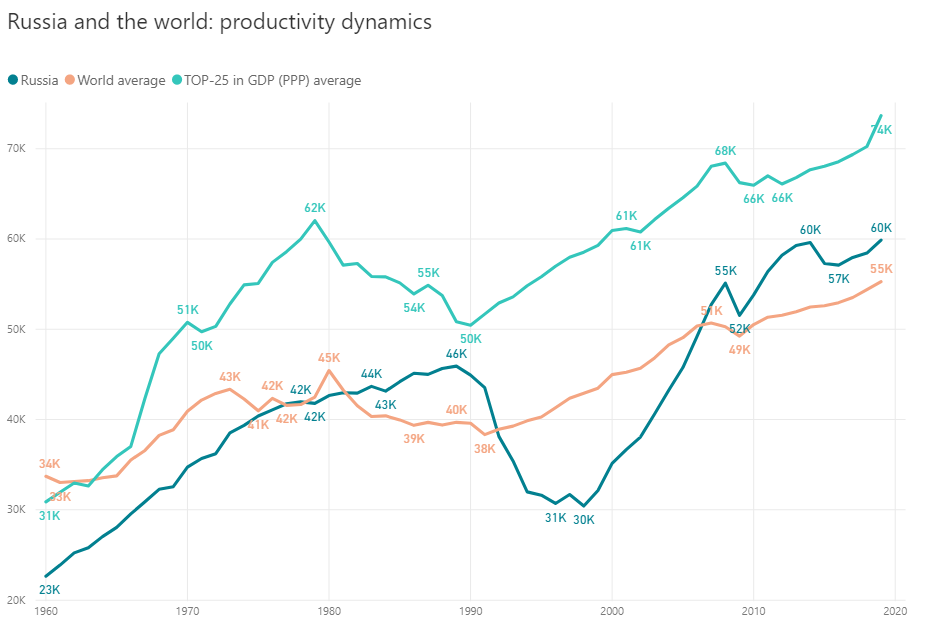
總結一下 (Let’s sum up)
Labor productivity is an important and interesting indicator of a country’s well-being. Watching its dynamics is as fascinating as watching the dynamics of GDP.
勞動生產率是一個國家福祉的重要而有趣的指標。 觀察其動態就像觀察GDP的動態一樣令人著迷。
The first place in the rating is a relative concept. You can always choose a scale that makes the chart look positive. You can learn how to avoid data manipulation and make clear visualizations in our analytics courses. Fill free to write to me and we’ll discuss all of your questions.
評分中的第一位是相對概念。 您始終可以選擇使圖表看起來更正的比例。 您可以在我們的分析課程中了解如何避免數據操縱并獲得清晰的可視化效果。 請隨意寫信給我,我們將討論您的所有問題。
翻譯自: https://towardsdatascience.com/labor-productivity-and-other-adventures-67212d1d199b
數據冒險控制冒險
本文來自互聯網用戶投稿,該文觀點僅代表作者本人,不代表本站立場。本站僅提供信息存儲空間服務,不擁有所有權,不承擔相關法律責任。 如若轉載,請注明出處:http://www.pswp.cn/news/388407.shtml 繁體地址,請注明出處:http://hk.pswp.cn/news/388407.shtml 英文地址,請注明出處:http://en.pswp.cn/news/388407.shtml
如若內容造成侵權/違法違規/事實不符,請聯系多彩編程網進行投訴反饋email:809451989@qq.com,一經查實,立即刪除!



![計算機網絡中 子網掩碼的算法,[網絡天地]子網掩碼快速算法(轉載)](http://pic.xiahunao.cn/計算機網絡中 子網掩碼的算法,[網絡天地]子網掩碼快速算法(轉載))











)


